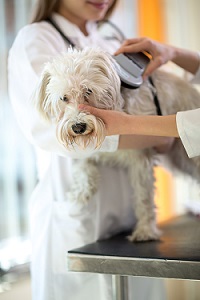
Your dog or cat could become lost or stolen. While pet owners do all they can to protect their beloved charges from thievery or escape from home or when on vacation, people and animals do separate. To avoid this heart wrenching situation, take precautions to protect your pet from escaping its protected environment.
Current technology offers a great help in recovering lost pets. It’s called the microchip, a tiny electronic device about the size of a grain of rice. It provides access to pet owner’s contact information if separation occurs. Drs. Covant and Bell at Bayview Seven Animal Hospital recommend microchipping pets to facilitate recovery of a lost or stolen pet.
How Microchips Work
Many animal shelters and veterinarians offer microchip implantation and scanning. Shelters often implant the chips as part of pre-adoption physicals along with immunizations and spay/neuter services.
The procedure is as simple and comfortable as administration of a vaccine. The Richmond Hill veterinarian injects glass enclosed microchip using a hypodermic needle. The chip resides under the skin between the shoulder blades.
The little device stays in place for the rest of the animal’s life. When scanned at a veterinary clinic or animal shelter, the chip activates and provides a pet identification number and owner contact information such as name, address and phone number. The American Veterinary Medical Association claims that lost dogs that are “chipped” return to their owners 52.2 percent of the time. For cats, the percentage is 38.5. Both numbers are significantly lower when animals don’t carry microchips.
Concerns about Chips
Pet owners worry about the possible side effects of microchipping, but your Richmond Hill veterinarians assure you that side effects are rare. The risks of the procedure are very small compared to the problems associated with losing a beloved pet. Infrequently, side effects may include:
- inflammation at the injection site
- migration of the chip from its original site
- infection
- tumor
Drs. Covant and Bell encourage questions about this wonderful procedure and are happy to explain the entire process to their clients. They advise test scanning a microchip each year with the dog or cat’s routine check-up to ensure the device still works. They also ask pet owners to update their contact information regularly with the national animal registry.
Learn More
If you have additional questions, the staff at Bayview Seven Animal Hospital will be happy to answer them. Microchipping adds an extra layer of protection to beloved animal companions. Call (905) 764-1144.
